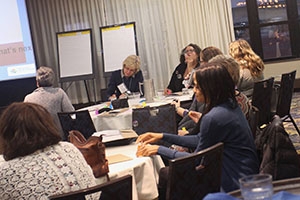Inviting Arts and Creativity into Food Policy Councils
A better title for this post might be “More Bubbles, Less PowerPoint,” because that was my greatest takeaway from the conference I attended in Minneapolis and Red Wing, Minnesota, in late November/early December. To that point—
Bing! As I hurried to catch the elevator, Melvin held the door and greeted me with an electric smile. His bright yellow African-print shirt was a welcome contrast to the rain in Minneapolis. I didn’t know we were both headed to the Convening of Food Network leaders’ meeting on the second floor. He was blessing colorful packages of blowing bubbles, the kind I used to buy for my sons’ birthday parties, to use at the start of the event. It was an auspicious kickoff.
I was there to give a keynote address, trying to avoid any didactic delivery of information. (My husband reminded me at the airport, “Keynotes are supposed to be funny.” That’s a tall order.) Melvin’s bubbles appeared on all the tables and we were encouraged to use them at any time—the equivalent of finger snapping in agreement, or a demonstration that the audience is with you, they’ve got your back, and they are showing you some love.
 This gathering of network leaders could have been a predictable event, with typical presentations, Q & A, discussion groups, etc. We’ve all been there. But it wasn’t typical. There was a great deal of of small group discussion, consulting circles, writing on tables and reflections from participants. The format generated a creative energy that I haven’t experienced in professional food policy gatherings.
This gathering of network leaders could have been a predictable event, with typical presentations, Q & A, discussion groups, etc. We’ve all been there. But it wasn’t typical. There was a great deal of of small group discussion, consulting circles, writing on tables and reflections from participants. The format generated a creative energy that I haven’t experienced in professional food policy gatherings.
The second half of my Minnesota week was spent at the James Shannon Leadership Institute, with 22 compatriots, exploring what it means to live your values in your work and personal life. As part of that exploration to discover my values, I have been part of a drumming circle, decorated a paper mask that reflected me, wrote in a journal, and participated in the creation of a group meal. I was re-introduced to Modge Podge, one of my favorite mediums as a child.
Funded by the Wilder Foundation, we are an assortment of nonprofit leaders, musicians, teachers, theater directors, lawyers, arts advocates, and foundation executives. It is the most diverse group I have ever been part of, and I felt that my cool quotient was raised up by my association with them—generally I cozy up to creativity but don’t embrace it. But when Dwayne Hartford, Artistic Director of Childsplay said, “We’ve got you convinced that we are the cool kids!” it suddenly dawned on me that the theater types may not have been the cool kids when they were growing up. Our culture doesn’t celebrate that kind of cool. But it should. We need to invite more creativity into our work lives, into our food councils, into our conversations with stakeholders. Theater elicits empathy, they reminded me. We need more empathy now.
I never thought about the role of the arts and creativity in food policy work until my first day at the Shannon Institute, when Mark Valdez, of ArtsValdez, told me about Art of the Rural, an organization whose mission statement includes “…through interdisciplinary and cross-sector partnerships to advocate for engaged conversation and policy that transcends imposed boundaries and articulates the shared reality of rural and urban America.” Sounds relevant. I know that several food policy councils have chefs as members. How about inviting visual, performing, and fine artists as well? How would our work look if we had them at the table? For those of you who already figured that out, how has engagement with creativity changed your work?
What if you purposely invited people already in your council to tap into their creative selves? In Big Magic: Creative Living Beyond Fear, Elizabeth Gilbert writes about how unimportant talent is in the creative process. The gist of it is that she couldn’t be bothered to listen to people talk about how their work isn’t good enough. She believes we are all creative beings that need to produce art, in whatever shape or form. Don’t just be consumers, be a producer. Write a beautiful policy brief, grow a garden, share a meal with 350 of your closest friends – like the Pittsburgh Food Policy Council did with their Sunday Supper Celebration.
We all need to be artists now. That’s the post-election message I got from Ronnie Brooks, our facilitator for the Shannon on Nov. 21 along with the Toni Morrison essay “No Place for Self-Pity, No Room for Fear,” from 2004: “There is no time for despair, no place for self-pity, no need for silence, no room for fear. We speak, we write, we do language. That is how civilizations heal.”
